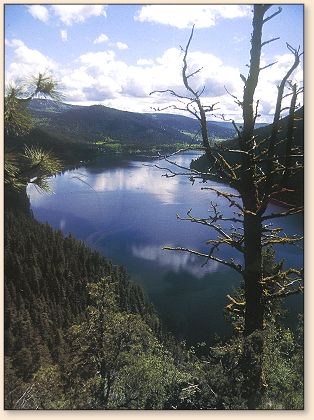Famous British Columbia
Fly-Fishing Waters
By Art Lingren
The Bill Nation Kamloops Area Lakes, Part 3
Next to Bill Nation, Jack Shaw stands tall
as a master of the sport and no work about
fly-fishing the lakes around Kamloops would
be complete without something about this
legendary fly-fisher. When Jack went fishing
it seems that trout, realizing their fate and
Shaw's skills as a fly-fisher and fly dresser,
lined up waiting their turn to be caught on
Shaw-dressed fly patterns. When less-skilled
fishers experience good catches, they can be
attributed more to luck, however, consistent
good catches don't just happen. Skill, knowledge,
experience, and observation, with a little luck
thrown in, are traits possessed by the great
fly-fishers.
Montreal-born Shaw moved to Burnaby at age nine
in 1925 and, like most youngsters with a yen for
the outdoors and fishing, started his angling
career with bait and hand-line fishing Burnaby's
south-slope creeks and the sea around Burrard Inlet,
False Creek, and English Bay. Those early day
catches consisted of small 8- to-10-inch rainbow
trout, bullheads, rock cod and flounder.
In 1940, Shaw moved to Kamloops and Jack started
his lake fishing career. In those early Kamloops
years, Shaw relied on his bait-fishing background
and used gang troll and worm, but soon, he realized
the errors of his ways and his fly-fishing career
was born.

Shaw was irritated by the existing trout patterns
with names that didn't identify what insect they
represented. In the early 1950s, Shaw developed
his own patterns and named them after the creatures
they represented. Later, when he became allergic
to dust from his automobile body-shop vocation,
his love of fishing proved the provider when he
took a fly-fishing representative and fly-tyer
position in a local sporting-goods store. The
store owner persuaded Jack to tie some of his
flies and offer them for sale, but the Shaw-invented
wingless patterns didn't sell. Being an observer
of nature, Shaw, an innovative fly tyer, developed
patterns to represent the insects on which fish fed.
He raised the insects in an aquarium and from macro
photographs dressed his imitations. However, they
didn't look like the normal winged-fly patterns of
the day, and fishermen are extremely conservative
and not quick to change unless convinced otherwise.
Jack was determined to persuade them otherwise.
Jack's concern about wingless, more-representative
flies and the resolve to persuade fishermen to use
his style of pattern has been well illustrated in
previous writings. However, as a fly-fishing/tying
teacher, Shaw did convince many of them otherwise
and, although some of those winged standards are
still popular, all lake fishermen fly inventory
include non-winged Shaw-type patterns.
Jack Shaw's book, Fly Fish the Trout Lakes,
came out in 1976, it detailed the equipment and
techniques for fishing the Kamloops area. However,
Shaw showed, by careful trimming of hackle or wing,
how to convert many of the standard-of-the-day
patterns into more life-like imitations of the
insects on which fish fed. Reprinted many times
it has become a standard reference for anglers
fishing the Interior.
Jack's second book, Tying Flies For Trophy
Trout was published in 1992. In it he
utilizes his vast reservoir of skill and knowledge
obtained from nearly 70 years of fishing, 50 years
of fly-fishing, 40 years of fly tying, and many
years as a fly-fishing/fly-tying teacher and sales
representative to give present and future generations
of anglers sound advice to catch those prized trophy
Kamloops rainbow trout. Jack passed away on February
2, 2000. Through his writing and his teaching he
contributed greatly to the lore of Interior fly-fishing. ~ Art Lingren
Continued next time.
Credits: From Famous British Columbia Fly-Fishing Waters, published by Frank Amato Publications. We appreciate use permission.
Our Man In Canada Archives
|

